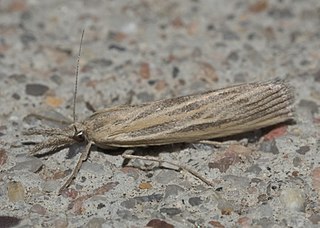Mesolia is a genus of moths of the family Crambidae described by Émile Louis Ragonot in 1889.

Prionapteryx is a genus of moths of the family Crambidae.

Thaumatopsis is a genus of moths of the family Crambidae.

Epinotia is a very large genus of tortrix moths. It belongs to the tribe Eucosmini of subfamily Olethreutinae.
Cauchas dietziella is a moth of the family Adelidae or fairy longhorn moths. It was described by William D. Kearfott in 1908. It is found in North America, including Alabama and Massachusetts.
Crambus youngellus, or Young's grass-veneer, is a moth in the family Crambidae. It was described by William D. Kearfott in 1908. It is found in North America, where it has been recorded from north-eastern United States and southern Ontario.
Fissicrambus intermedius is a moth in the family Crambidae. It was described by William D. Kearfott in 1908. It has been recorded from the US states of Arizona, California and Texas.
Microcrambus polingi is a moth in the family Crambidae. It was described by William D. Kearfott in 1908. It is found in the US state of Arizona.

Pediasia dorsipunctella is a moth in the family Crambidae. It was described by William D. Kearfott in 1908. It is found in North America, where it has been recorded from Alberta, Arizona, California, Manitoba, Montana, Nevada, North Dakota and Ontario. The habitat consists of grasslands.
Thaumatopsis crenulatella is a moth in the family Crambidae. It was described by William D. Kearfott in 1908. It is found in the US states of Arizona, California, Colorado and Nevada.
Thaumatopsis fernaldella is a moth in the family Crambidae. It was described by William D. Kearfott in 1905. It is found in North America, where it has been recorded from Alberta, California, Florida, Maryland, Mississippi, Nevada, New Mexico, Oklahoma, Saskatchewan and Texas. The habitat consists of prairies.
Thaumatopsis floridella, the Floridian grass-veneer, is a moth in the family Crambidae. It was described by William Barnes and James Halliday McDunnough in 1913. It is found in North America, where it has been recorded from coastal areas in Florida, Georgia, Mississippi, South Carolina and North Carolina, New Jersey, New York, and Rhode Island. It is also found in Cuba.

Thaumatopsis pexellus, the woolly grass-veneer, is a moth in the family Crambidae. It was described by Philipp Christoph Zeller in 1863. It is found in most of North America. The habitat consists of grasslands.
Eoreuma multipunctellus is a moth in the family Crambidae. It was described by William D. Kearfott in 1908. It has been recorded from the US state of Arizona.
Xubida puritellus is a moth in the family Crambidae. It was described by William D. Kearfott in 1908. It is found in the US state of Arizona.
Hemiplatytes parallela is a moth in the family Crambidae. It was described by William D. Kearfott in 1908. It is found in the US states of Arizona and New Mexico.
Mesolia huachucaella is a moth in the family Crambidae. It was described by William D. Kearfott in 1908. It is found in the US state of Arizona.
Mesolia oraculella is a moth in the family Crambidae. It was described by William D. Kearfott in 1908. It is found in the US state of Arizona.
Prionapteryx indentella, the buffalograss webworm, is a moth in the family Crambidae. It was described by William D. Kearfott in 1908. It is found in the US states of Kansas and Texas.
Prolita invariabilis is a moth of the family Gelechiidae. It was described by William D. Kearfott in 1908. It is found in the US states of Utah, Wyoming, Arizona, California, Colorado, Oregon and New Mexico.


